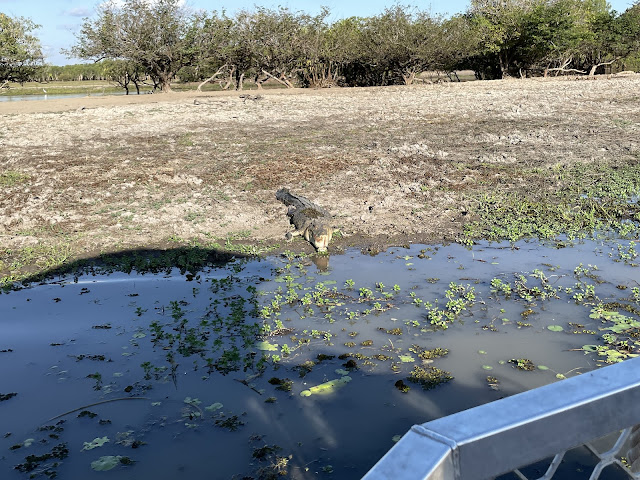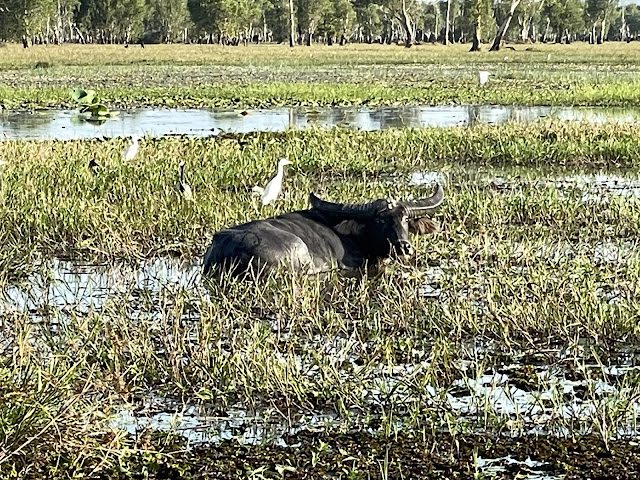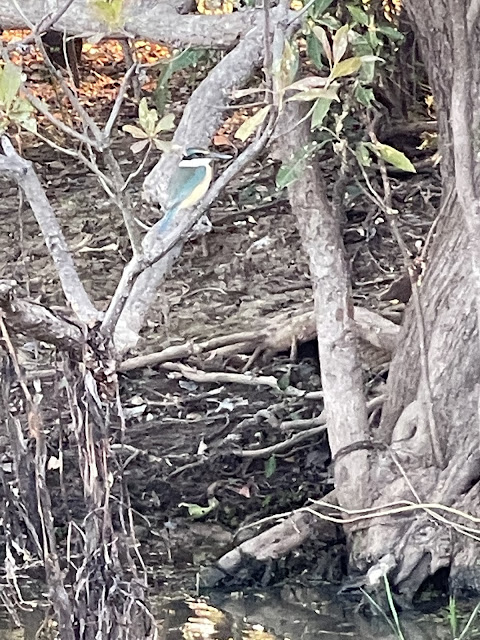Our destination for the day was Yellow Waters Campgound at Cooinda Lodge at Kakadu National Park. We were staying here due to its proximity to the Yellow Waters Billabong. A billabong is a permanent waterhole beside a river.
This was another place that you had to book and pay online before arrival. Boy, do these websites make it difficult. We are both pretty computer savvy and have trouble, so it must be so difficult for those with little knowledge or none at all. There is no option to book over the phone. We called the reception area for assistance, but they advised no one could talk to us and to send an email. Helpful - not! After much fiddling, we finally booked a powered site for the night. Once booked online, you are given a passcode for the boom gate. Guess what? It doesn’t work! Grrr! A visit to the hotel reception area and finally someone gave us an alternate code, which luckily did work. Phew!
Once we were in, it was a lovely place to camp. The best thing is the pool area, where we spent most of the afternoon. There is a lovely waterfall area at the back. Apparently it cost one million dollars to create this space. Very enjoyable.
The reason we were camped here was that we were going on a Yellow Waters Sunset Cruise, which is pretty famous. We left at 4.30pm, getting back about two hours later. As we only booked the day before, we were rather surprised that there were places available. It turns out that they have six boats. Only four were in use that night. We were lucky to get a seat up the front.
Kakadu National Park is the most famous one in the top end, for its saltwater crocodiles, bird life and fishing. The cruise takes you over a wide area where you see the birds and animals in their natural environment. There is no feeding crocodiles to make them jump out of the water, rather we just observe whatever is taking place at that particular time. Our guide, Chris, was really interesting.
It was’t long until we say our first crocodile, just with its back out of the water. It was swimming around looking for prey, mainly fish, but we didn’t see it catch anything.
We saw a few more swimming or just laying next to the bank and then we saw this one on the bank, with its mouth open. Chris edged the boat closer and closer. My seat was the closest to her and we were even closer than this. I was a little nervous, to say the least.
She was very bloated, so was sitting on the bank waiting for the food to digest. It was hot, so her mouth was open as the top of her mouth has blood vessels close to the surface which help to cool her down. Chris said she would be appreciative of the shade from the boat - see how much closer we were than in the first photo. I was happy when we moved on. She is a large female, but the alpha males are even larger.
There were lots of lotus plants in the billabong. They close their flowers at night.
Chris was keen to show us a bird that lives in the lotus and walks on the leaves. It is the Jacana. It is hard to see, but it has these really long toes on its feet for walking on the leaves, apparently the longest body to toe ratio of any bird. He was also able to show us some juveniles.
We saw a buffalo wallowing in the flooded grasses with a crane on its back. The wildlife are so used to the boats going past that they just get on with their business without taking too much notice.
As it is getting late in the dry season, the water level is getting quite low.
Once the sun was getting lower, the colours and reflections were beautiful. The main trees were pandanus and paperbark.
This tree was struck by lightning some years ago and they reckon it looks like a crocodile jumping out of the water. I can sort of see it.
One of the other boats. There was plenty of room for them all to move around without getting in each other’s way.
Chris was trying to show us three types of kingfisher birds that live in the area. The first was a Tree Kingfisher. Apparently the books say it lives entirely on insects, but Chris has seen one catch a fish, so he says they live “mainly” on insects. I was unable to get a photo of it on my phone.
The second was the Azure Kingfisher. This one I did get a photo of, although not the best. It was amazing how close the boat was able to get.
He then went looking for a Little Kingfisher, which is apparently really rare. Twitchers will travel from all over the world to see this bird. He looked in one likely spot with no luck, so tried another. Bingo. There it was. It definitely was little. Once again, we were able to get incredibly close. Chris churns up the water, which helps stir up the fish the bird catches, He reckons by doing this the bird is happy to let him close. Isn’t it beautiful. The colours are so rich.
By then the sun had set and the buffalo, an introduce animal, were emerging to come to the water. The larger crocodiles are quite capable of taking a calf.
The increase in the number of feral pigs in the area are another source of food for the crocs. Recently, one of the boat trips witnessed a croc taking a pig, drowning it with the death roll, before belting it around to break it up to let it swallow it. Then, another croc came and attacked the first croc! Yes, they will kill each other over territory. One male will have many females. At the moment they estimate that there is a croc about every 20 metres, as the water drops further, there will be a croc at about every 15 metres. Since they have become protected, their numbers have started to be out of control.
The rangers have a cull of the buffalo and pigs each year, so they don’t get totally out of control, as they do quite a bit of damage to the ecosystem.
There are loads of ducks and herons along the shoreline. What was interesting is that crocs can’t digest feathers, so rarely eat birds. Lucky birds.
Finally, towards the end our our tour we saw a couple of jabiru. Such an elegant bird. We did see one catch a fish.
We didn’t see a crocodile catch anything, unlike the previous night, when one of our mates from home was on the tour and they saw a croc take a really large fish. He caught a great photo of it.
By the way, as the water level is now very low, the oxygen levels in the water is also low and some catfish are succumbing to it. There are still lots of barramundi, but Chris said it is more catch and release in this area at the moment. You wouldn’t want to eat one until fresh water comes in when the wet season starts.
A couple more photos of the lovely view as we head back towards the jetty.
Lastly, see the pontoon. Back in 2007 there was a flood here with 800mls of rain in a day. That pontoon floated off the top of those pylons. The entire resort was flooded with the staff and guests having to climb onto the highest roof and be rescued by helicopter. After that, it was the huge clean up and removing all the crocs that had ended up in the resort. Only in the Territory.
I know Mick has taken better photos, particularly of the birds with his camera. I may substitute some of his for mine a bit later on.
The highlight of the day was of course the cruise. So enjoyable.


























3 comments:
Thanks Janice, been on the computer for "awhile" tonight, but have caught up on your post. Fantastic photos and great descriptions of your trip.
Lovely to see the wildlife, especially the king fishers.
Slowly catching up here! That was a great boat trip, lucky you got to see all the kingfishers. I wouldn't want to get close to any of those crocodiles.
Post a Comment